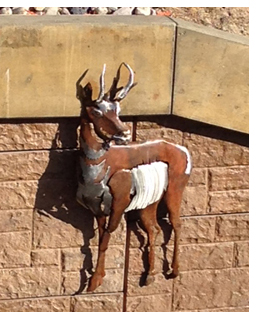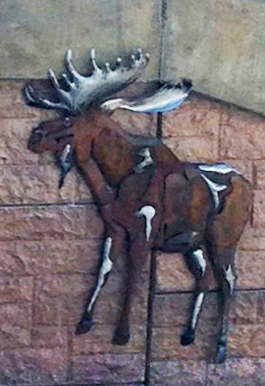

Pictured above is the soaring eagle used on the interchange fence. Below right is Salmore; below left is the pronghorn; at bottom right is the moose.
Chubbuck’s new interchange features iconic wildlife, Salmore’s vision
 The new Diverging Diamond Interchange in Chubbuck is one-of-a-kind in several ways. Besides being the first interchange of its kind in Idaho, it also is aesthetically a showcase for the initiative and vision of District 5 Sr. Environmental Planner Alissa Salmore and a tip of the cap to the iconic species found in that region of the state.
The new Diverging Diamond Interchange in Chubbuck is one-of-a-kind in several ways. Besides being the first interchange of its kind in Idaho, it also is aesthetically a showcase for the initiative and vision of District 5 Sr. Environmental Planner Alissa Salmore and a tip of the cap to the iconic species found in that region of the state.
The interchange connects U.S. 91/Yellowstone Highway over the Interstate 86 system. The new $10.8 million project opened to traffic by Nov. 1, 2013. Crews are still wrapping up the project in its entirety. The art items mentioned here were just completed. The landscaping will not be closed out until next year at the earliest.
“In determining the animals to select from, we started with that list of regionally significant and common species. Because we could only do a couple, we made selections based on moose being more common in the local area than elk, and pronghorn having more fur patterning than deer (and therefore producing a more showy image),” explained Salmore. “That is how we ended up selecting those two species.”
Salmore also gives a nod to the ITD staff responsible for translating her ideas into a built project. “I worked with the District 5 and ITD Headquarters’ bridge designers on the aesthetic treatments, with ongoing support from the district’s Residency staff during construction in order to implement those ideas,” she explained.
Creating a collaborative environment also was necessary to move from concept to fruition. Salmore provided photo images to the fabricator of the types and how many of the animals she wanted to be represented, and a metalsmith translated the photos into metal images.
“We worked with the contractor on design — they worked with a Utah artist who translated our ideas into fabricated pieces,” Salmore explained.
Once fabricated, the contractor installed the images where Salmore wanted them.
“I pulled some photos from the web and submitted them to the contractor to use to design the metal figures. I had the idea to put birds of prey up above on the parapet fence, and I submitted photos of bald eagles and red-tail and Swainson hawks for  generating the metal figures for the raptors. We planned on big-game animals on the abutment walls, but added some additional birds of prey to the abutments as well,” she said.
generating the metal figures for the raptors. We planned on big-game animals on the abutment walls, but added some additional birds of prey to the abutments as well,” she said.
There is logic to placement — The moose hangs along the eastbound lane of Interstate 86 as drivers head into the mountains where moose occur, and the pronghorn is on the westbound lane facing the Snake River plane, as drivers head toward antelope country.
Design plans were finalized in July or August and metal images were fabricated and installed in October. The birds of prey range in size from three to four feet long, and the moose and pronghorn are about 8-foot tall by 6-foot wide (the pronghorn is a little smaller, maybe 6 feet by 6 feet). There are nine birds on the parapet fencing along the dedicated pedestrian walkway that runs through the middle of the Interchange bridge. The contractor put one moose and one pronghorn on the abutment walls, and two birds each opposite the large animals.
Additionally, bridge aesthetics included concrete color for parapet, piers, island paving, and retaining-wall panels, as well as formliner molds to apply stone and stylized grass patterns to some of the surfaces. Metal elements (fence, rail, utility poles, sign mounts) also were powder-coated to be brown, which coordinated with the concrete colors. Landscaping — which will take another year or two to grow in — will include native trees, shrubs and grasses.

Published 11-07-14